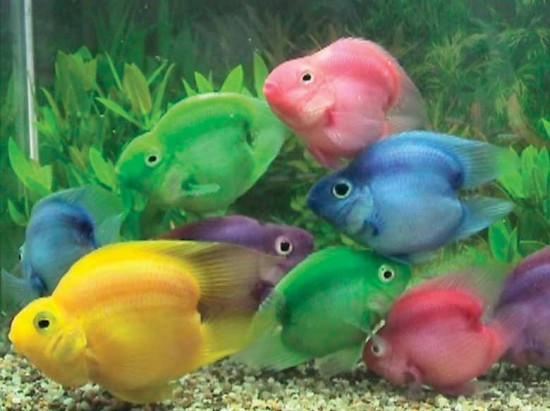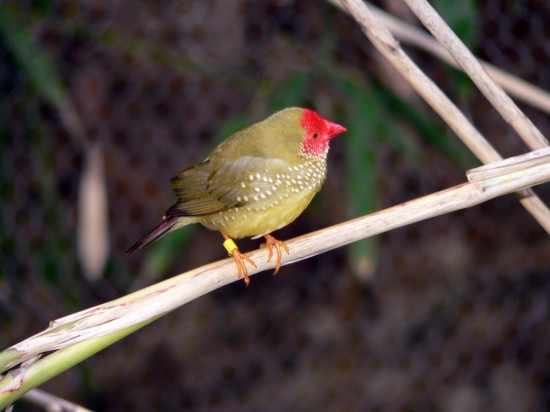

Most fish keepers of both tropical and marine tanks like to keep bright, vibrant and colourful species, and so, there is significant demand for fish like these within the aquarium trade. Many people also seek to keep the type of patterned and coloured fish you usually only see within marine tanks within a simple freshwater aquarium setup, but find that tropical fish rarely appear as bright and visually impressive as their marine counterparts.
This consumer demand has led to an unusual and highly unethical practice among some commercial fish keepers and breeders: artificially dying their fish to meet the ongoing demand. If you didn’t realise that this happens and are rather shocked by the idea, you are not alone! So, why is dying fish bad, and how can you avoid buying a dyed fish? Read on to learn more.
The very concept of dying fish horrifies most hobbyist aquarium keepers, but not everyone understands specifically why it is problematic. Obviously, dying is an unnatural process, as is handling fish, and even more so, introducing a dye or foreign reagent into their bodies for aesthetic purposes. Fish that have been dyed will almost certainly have a much shorter lifespan than natural fish, and will be exponentially more prone to developing illnesses and infections as a result of dyeing.
Depending on the process used to dye the fish, in some cases less than 50% of the dyed fish will actually survive the procedure; but the ready availability of more fish and the higher prices that dyed fish can command make it worthwhile for some unscrupulous commercial breeders.
The dying process is painful and stressful for the fish, and also potentially stunts their growth and development. Once you have bought a dyed fish, they will gradually lose their colour over time as their bodies metabolise the dye, while at the same time, shortening their lifespan as their bodies struggle to process the foreign ingredient.
Adding a dyed fish to an existing tank can also be dangerous for the other fish in the tank, as the weakness that the dye produces means that the fish may also introduce illness to the tank, as well as the added complication of the by-products of the dye’s breakdown.
There are three different methods of dying fish, none of which are healthy, but some of which are worse than others.
Injecting dye directly under the skin of the fish is the most common way to colour a fish, and also the most harmful. Injecting dye can be likened to tattooing in people, meaning that multiple injections need to be made across the body of the fish to achieve an even colouration, with a needle that would be the equivalent size to using a needle the size of a pencil on a person.
Understandably this is very painful for the fish, and all of the multiple puncture wounds it causes can all harbour infections.
Fish dipping works rather differently to injection dying, but is also very harmful in a range of ways. The bodies of fish are naturally coated in a thin, mucous-like slime to protect them from trauma and infections, which poses a barrier to making an artificial dye take hold.
Ergo, in order to dye a fish by dipping, the fish are first bathed in a caustic solution that is designed to remove the natural mucous layer, and then dipped into a bath of dye or injected by the method outline above. The whole process is highly painful and irritating to the skin and scales of the fish, and again, will affect their general health and shorten their lives.
Fish will sometimes change hue and colour depending on the type of food that they are fed, and so deliberately feeding coloured, dyed food can also promote fish to deepen in colour or appear darker and brighter. Some natural foods that fish would eat in the wild achieve this result naturally, and you can buy perfectly appropriate colour-enhancing foods for your fish too,
However, in order to deliberately dye fish, the third possible method is to dye the food that the fish are given, which will cause the colour to brighten only for as long as the fish eats this food, and they will then fade when changed back onto a natural diet.
A wide range of different species of fish may be dyed, and unless your aquarium retailer is vigilant about purchasing only un-dyed fish and has a policy to this effect, you may find yourself browsing through dyed fish without even realising it.
Before you go fish shopping, search on the internet to find out the natural colour variations of the fish that you are considering, and take any graduations from this norm, or very very bright colours, as a warning sign.
Some of the fish that are most commonly sold dyed within the UK include the Parrotfish, the Glassfish and the Cory, although a great many other fish may also be subject to dyeing too.
 Neochmia Finches - The Star Finch And Cherry Finch
Neochmia Finches
Neochmia Finches - The Star Finch And Cherry Finch
Neochmia Finches
 Are Vaccination For Life Schemes Good Value For Money?
Are Vaccination F
Are Vaccination For Life Schemes Good Value For Money?
Are Vaccination F
 Is A Springer Spaniel The Right Choice Of Dog For You?
Is A Springer Spa
Is A Springer Spaniel The Right Choice Of Dog For You?
Is A Springer Spa
 An introduction to pet micro chipping
An introduction to pet micro chipping
One litt
An introduction to pet micro chipping
An introduction to pet micro chipping
One litt
 Strange Cat Behaviour After Moving Home – Should You Worry?
Strange Cat Behav
Strange Cat Behaviour After Moving Home – Should You Worry?
Strange Cat Behav
Copyright © 2005-2016 Pet Information All Rights Reserved
Contact us: www162date@outlook.com